Seeds of Serenity: Crafting a Spiritual Garden Sanctuary for Every Path
The gentle rustle of leaves in the breeze and the soft gurgle of a nearby stream filled the air as I watched my friends from various faiths wander through the garden. Sarah, a good friend of mine, is devout Buddhist, paused to admire the carefully raked sand patterns, while Michael, who is a Christian minister, found solace among the fragrant roses in the same garden. A few days earlier Priya, a Hindu client, had discussed with me the possibilities of geometric patterns in the walkway when we designing her personal sanctuary.
Gardens have long served as spaces for contemplation, meditation, and connection to the divine across cultures. From ancient Mesopotamian paradise gardens to Japanese Zen retreats, these green sanctuaries have offered refuge for the soul.
Creating spiritual gardens that respectfully incorporate elements relevant to spirituality of various belief systems while remaining accessible and welcoming pose can unique challenges but there are simple solutions available . The goal is to craft a space for personal reflection and community gathering that resonates with believers and non-believers alike.
Buddhist Reflections in the Garden Space

Zen Inspiration – The Art of Minimalism, Tranquility, and Natural Beauty
Zen gardens embody simplicity and mindfulness, core tenets of Buddhist practice. These spaces invite visitors to slow down, breathe deeply, and connect with the present moment. A rock garden or sand raking area offers a focal point for meditative contemplation.
To create a Zen-inspired space, select a quiet corner of your garden. Install a small, rectangular area filled with fine gravel or sand. Add a few carefully placed rocks of varying sizes and shapes. Provide a rake for visitors to create their own patterns, encouraging mindful focus and creativity.
Moss gardens complement the minimalist aesthetic while adding a lush, green element. Choose shade-loving moss varieties and plant them among rocks or at the base of trees. The soft, velvety texture invites touch and quiet reflection.
Incorporating Prayer Wheel Stones
Small, round stones can represent prayer wheels within the landscape, subtly integrating Buddhist spiritual elements without overwhelming non-Buddhist visitors. Arrange smooth river rocks in a circular pattern along a path or around a central feature. Visitors can interact with these stones, turning them as they walk or pausing for a moment of reflection.
Plant selections can further enhance the Zen aesthetic. Consider adding:
- Bonsai trees: These miniature marvels symbolize patience and the harmony between man and nature.
- Bamboo: Known for its strength and flexibility, bamboo represents resilience and adaptability.
- Japanese maples: With their delicate leaves and graceful form, these trees add elegance and seasonal interest.
A small koi pond can serve as a focal point, its shimmering surface and graceful fish movements encouraging quiet contemplation. Ensure proper filtration and maintenance to keep the water clear and healthy for the fish.
Seasonal Rhythms
Align garden elements with the seasons of reflection and celebration in Buddhism to create an ever-evolving sacred space. Select plants that showcase the impermanence of life and the beauty of change:
- Spring: Plant cherry trees or flowering plums to celebrate new beginnings and renewal.
- Summer: Incorporate lotus flowers in water features, symbolizing purity and enlightenment.
- Autumn: Choose trees with vibrant fall foliage, such as ginkgo, to represent the transient nature of life.
- Winter: Highlight evergreens and bare branches, inviting reflection on the cycle of life and death.
As the garden changes throughout the year, it offers opportunities for visitors to connect with Buddhist teachings on impermanence and the cyclical nature of existence.
Christian Spirituality in Green Spaces
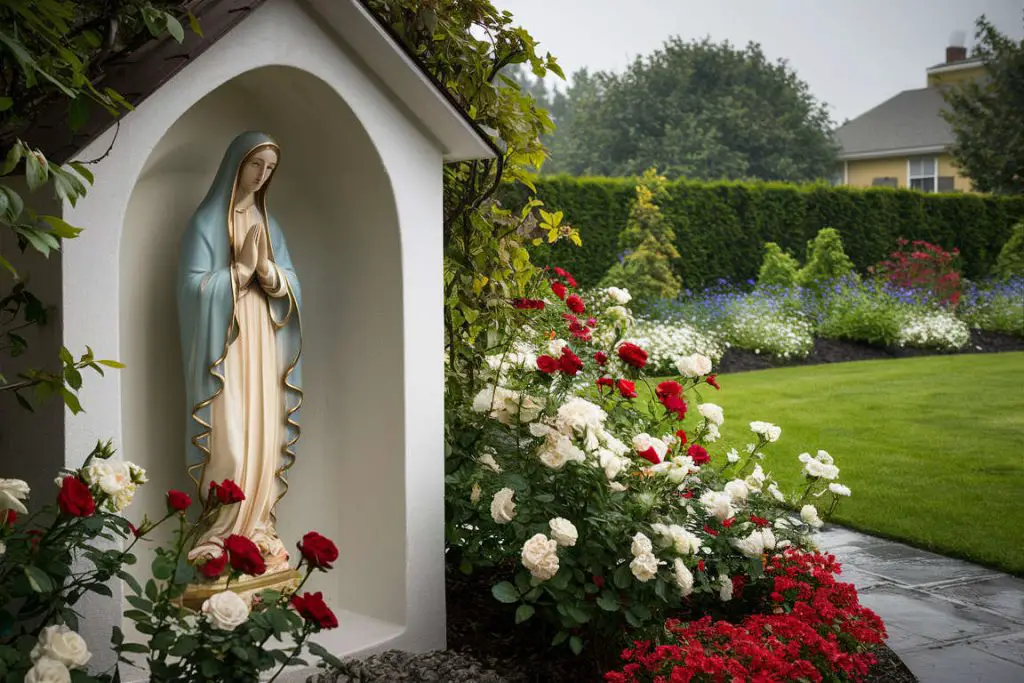
Sacred Plants
Choosing flora associated with peace and eternal life creates an environment that draws upon rich scriptural symbolism while offering solace to all visitors. Integrate plants like:
- Olive branches: Symbolizing peace and reconciliation
- Lilacs: Representing the joy of spring and new life
- Lilies: Often associated with purity and resurrection
These plants can be appreciated aesthetically by everyone, providing comforting scents and visual beauty without being exclusive markers of Christianity. When selecting and placing these plants, consider their growth habits and care requirements to ensure they thrive in your garden’s conditions.
Memory Gardens
Creating spaces dedicated to remembrance honors all loved ones lost or absent from one’s life, regardless of religious belief. Roses, universal symbols of love, can form the centerpiece of a memory garden. Choose a variety of colors and fragrances to appeal to different preferences and memories.
Incorporate non-denominational markers or seating areas where visitors can pause and reflect. A simple stone bench or a small water feature can provide a focal point without overtly religious connotations. Consider adding:
- Forget-me-nots: Delicate blue flowers that speak to remembrance
- Rosemary: Known for its association with memory and fidelity
- White tulips: Symbolizing forgiveness and worthiness
Design these areas thoughtfully, ensuring they remain respectful and inclusive for visitors of all backgrounds.
Meditative Walkways
Pathways winding through the garden can guide visitors on a journey of quiet contemplation. Line these paths with reflective surfaces like shallow water bodies or polished stones. The gentle sound of water or the play of light on smooth surfaces can inspire introspection.
Consider creating a labyrinth pattern in your pathway design. Labyrinths have been used in Christian traditions for centuries but also appeal to those seeking a meditative walking experience regardless of faith. Use materials that blend with your garden’s overall aesthetic, such as:
- Smooth river stones: For a natural, organic feel
- Reclaimed brick: Adding warmth and character
- Crushed seashells: Offering a coastal vibe and pleasant crunching sound underfoot
Arrange these materials to invite introspection, encouraging visitors of all beliefs to find personal meaning and solace in their own way as they traverse the garden.
Hindu Devotion & Aesthetics
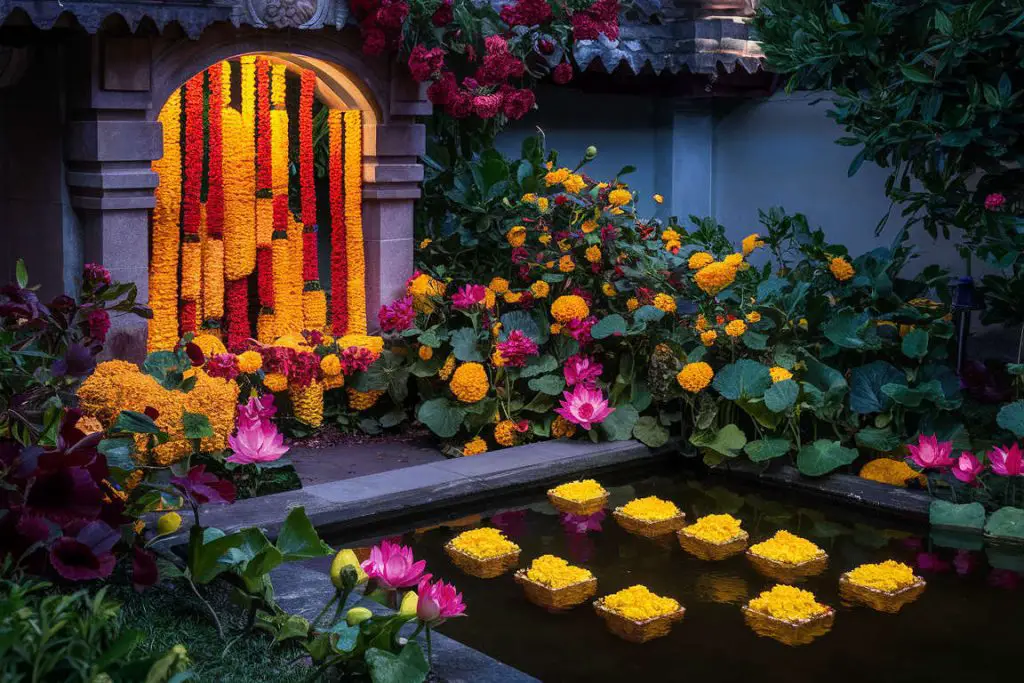
Splendorous Sanctity
Hindu traditions often embrace vibrant colors and lush flora, mirroring the rich palette found within temples. Incorporating this aesthetic offers an approachable option for visitors to feel inspired without feeling excluded.
Create a dedicated area bursting with colorful blooms. Choose flowers like:
- Marigolds: Bright orange and yellow flowers associated with purity and positivity
- Lotuses: Symbolizing divine beauty and spiritual awakening
- Jasmine: Prized for its sweet fragrance and connection to devotion
Integrate these flowers into the overall garden design while providing spiritual significance. Focus on harmonious integration with existing local flora to ensure ecological sensitivity alongside cultural respectfulness.
Consider adding a small water feature adorned with floating flowers or candles, reminiscent of offerings made in Hindu temples. This element can serve as a focal point for quiet reflection or gentle meditation.
Sacred Geometry
Use mandalas or lotus-patterned walkways as a nod to Hindu artistry and philosophy. These intricate designs invite appreciation of geometry in nature while subtly guiding visitors through the garden.
Create a circular paved area with a mandala pattern using:
- Colored stones or tiles
- Carefully arranged plants in concentric circles
- Painted designs on a flat surface
Ensure these patterns maintain the garden’s accessibility for personal reflection. Visitors can trace the patterns with their eyes or fingers, finding a meditative rhythm in the repeating shapes.
Celtic Spirituality & Nature’s Whisper
Druid Groves
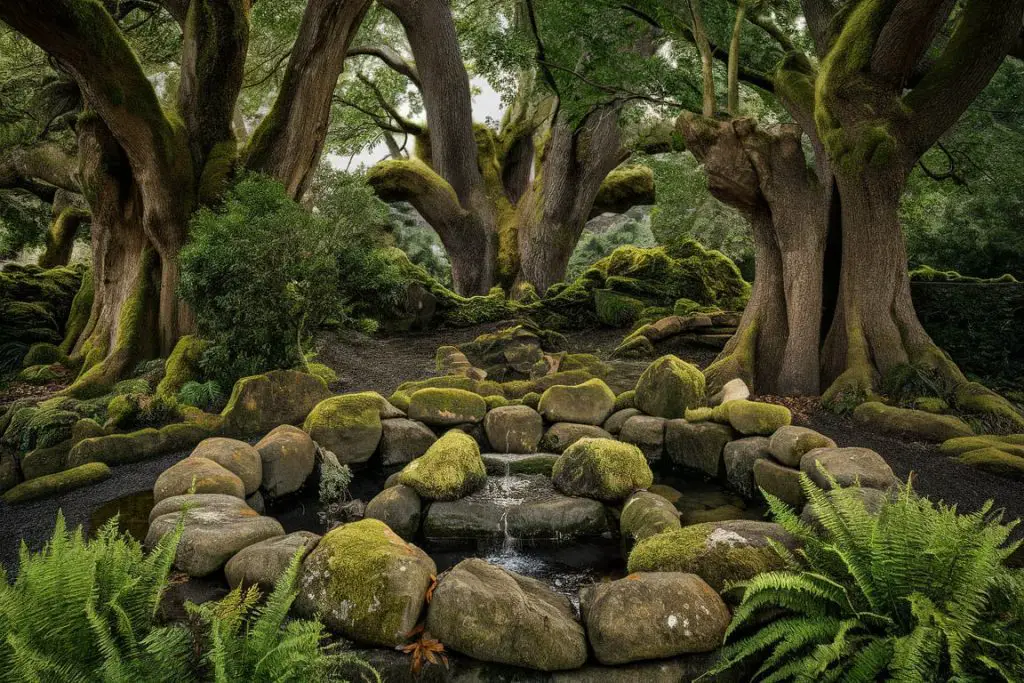
Plant an area with ancient trees and mossy rocks to evoke old-world sanctuaries. This space represents the deep connection between nature, spirituality, and historical practices in Celtic culture.
Choose trees with historical significance in Celtic lore, such as:
- Oak: Symbolizing strength and wisdom
- Rowan: Associated with protection and healing
- Hawthorn: Linked to fairy folk and magical properties
Integrate natural stone formations that evoke a Druid circle. Arrange large boulders in a rough circle, leaving spaces for visitors to enter and exit. Allow moss and lichens to grow naturally on these stones, enhancing their ancient appearance.
Design water features reflective of ancient rituals while remaining inviting for all visitors. A small, bubbling spring or a still pool surrounded by ferns can create a sense of mystery and connection to the earth.
Celestial Inspirations
Align outdoor spaces with celestial events to connect modern seekers with ancient Celtic spirituality. Create skyward garden structures or reflective water bodies that capture moonlight.
Consider installing:
- A sundial as a central feature, marking the passage of time
- An archway aligned with the summer solstice sunrise
- A reflective pond positioned to mirror the night sky
These nature-inspired installations celebrate both heavenly and earthly presences. They invite visitors to contemplate their place in the cosmos, regardless of their spiritual background.
Pagan Traditions and Nature Worship
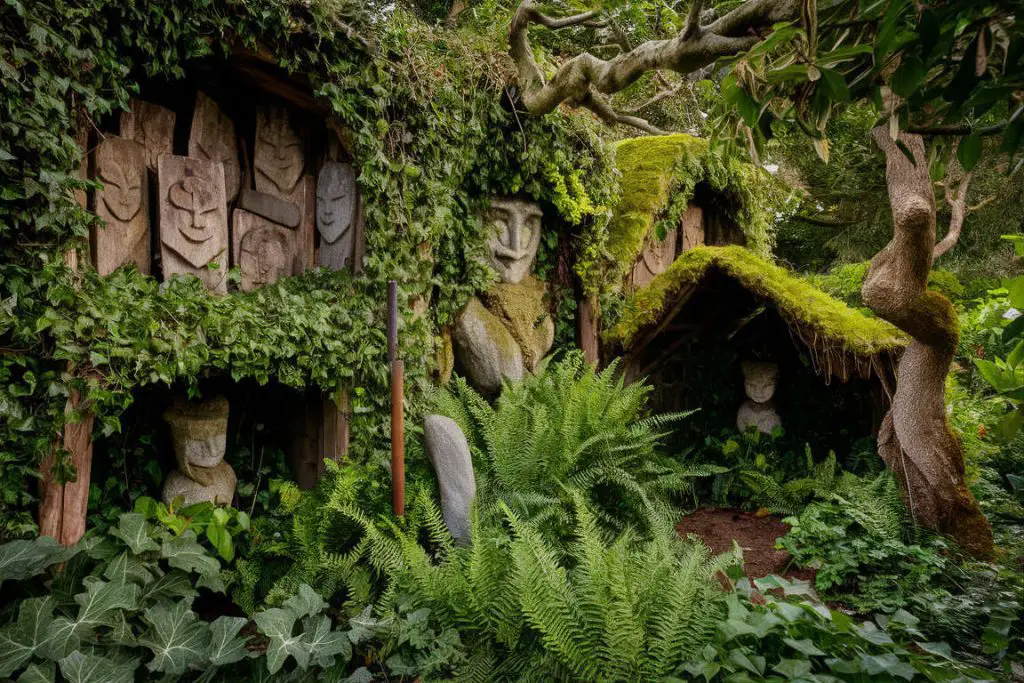
The Green Man and Forest Spirits
Pagan traditions often celebrate the intrinsic connection between humans and nature. The Green Man, a legendary being symbolizing the cycle of growth and rebirth, serves as a powerful motif in pagan-inspired gardens.
Incorporate Green Man imagery through:
- Carved wooden plaques hidden among foliage
- Stone sculptures peeking out from ivy or climbing plants
- Living sculptures made from trained vines and moss
Surround these features with lush, green plants that embody the spirit of forest deities:
- Ferns for their ancient lineage and delicate beauty
- Oak trees, sacred in many pagan traditions
- Ivy, representing immortality and tenacity
Create secluded nooks within dense plantings, evoking the feeling of stumbling upon a secret glade in an enchanted forest.
Sacred Circles and Stone Arrangements
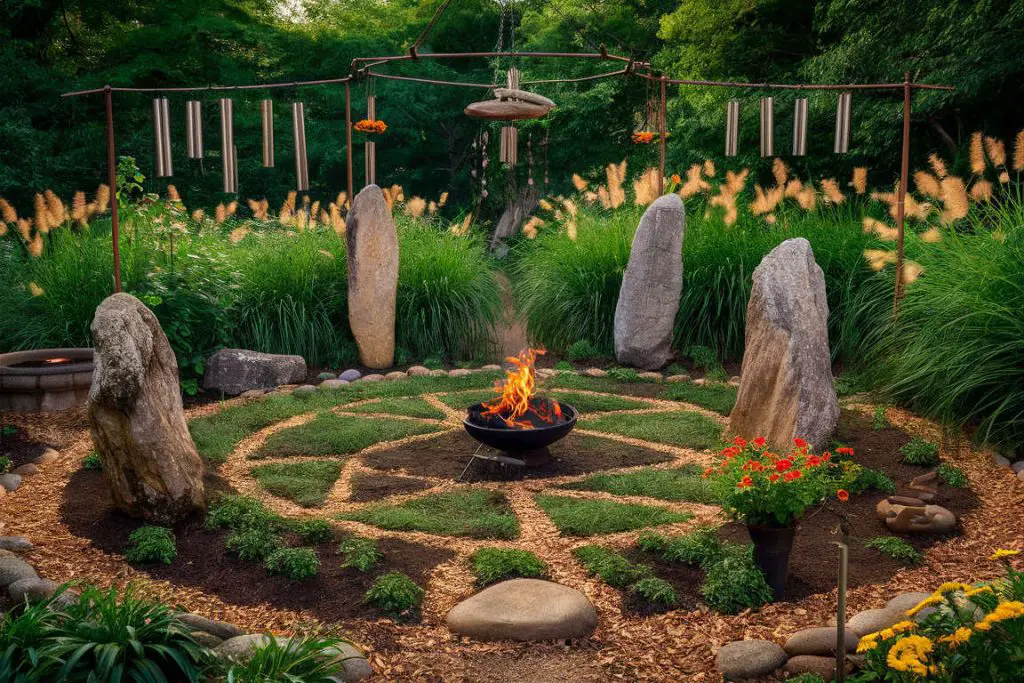
Many pagan traditions use circular formations for rituals and celebrations. Design a sacred circle within your garden using:
- A ring of standing stones or wood posts
- A circular herb garden with paths forming a pentagram
- A labyrinth mowed into a grassy area
Within or around these circles, incorporate elements representing the four classical elements:
- Earth: A large, flat stone or a mound of soil
- Air: Wind chimes or tall, swaying grasses
- Fire: A fire pit or red and orange flowers
- Water: A small fountain or birdbath
These features invite contemplation of natural cycles and elemental forces, resonating with pagan beliefs while remaining accessible to all visitors.
Herb Gardens and Plant Magic
Many plants hold significance in pagan traditions for their magical or medicinal properties. Create a dedicated herb garden featuring:
- Rosemary: For protection and purification
- Sage: Used in smudging rituals
- Lavender: Associated with love and tranquility
- Mugwort: Linked to divination and prophetic dreams
Arrange these herbs in spiral patterns or concentric circles, adding both visual interest and symbolic meaning. Include informational placards about each plant’s traditional uses, fostering education and appreciation for plant lore.
Seasonal Celebrations
Pagan traditions often mark the changing seasons with festivals and rituals. Design your garden to highlight these transitions:
- Plant bulbs that bloom during Imbolc (early February)
- Create a Maypole area for Beltane celebrations (May 1st)
- Dedicate a harvest corner for Lammas (August 1st)
- Include evergreens and holly for Yule (winter solstice)
These seasonal focal points serve as reminders of nature’s cycles and provide opportunities for reflection throughout the year.
Moon Gardens
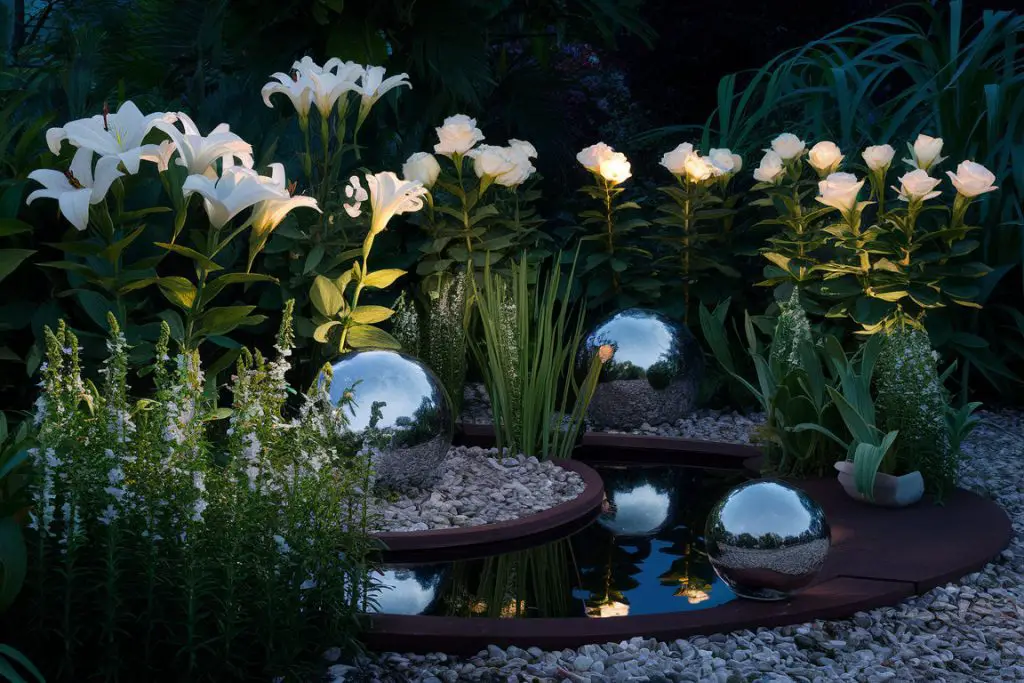
Many pagan practices involve lunar cycles. Design a moon garden featuring:
- White or pale-colored flowers that glow in moonlight
- Night-blooming plants like evening primrose or moonflower
- Reflective surfaces like gazing balls or still water
Position this area to catch moonlight, creating a magical atmosphere for nighttime contemplation or rituals.
Incorporating these pagan-inspired elements into your spiritual garden can honor nature-based traditions while offering a space for all visitors to connect with the natural world. The key is to create an atmosphere of mystery, reverence for nature, and celebration of life’s cycles that resonates with pagan beliefs while remaining inviting to those of all spiritual backgrounds.
Universal Spiritual Symbols & Unity in Diversity

Interfaith Inclusivity
Design shared garden spaces that are neutral yet welcoming, using elements such as a central fountain or communal seating area. These features center the space around universality and common ground found across spiritual practices.
Create a circular seating area with benches or comfortable stones arranged to encourage conversation and shared reflection. In the center, install a simple water feature or a sculpture with broad spiritual significance, such as a globe or an abstract representation of unity.
Allow individuals to bring their own personal touches to this space. Provide small niches or shelves where visitors can leave meaningful objects, create temporary arrangements, or add to a communal art piece.
Reflective Ponds
Water features serve both practical purposes for garden health and symbolize purification, renewal, or baptism in various traditions. Design a series of small, interconnected ponds or a larger reflective pool.
Balance the symbolic importance of water with ecological considerations:
- Implement rainwater harvesting systems to maintain water levels sustainably
- Choose native aquatic plants to support local ecosystems
- Install simple filtration systems to keep water clear without excessive chemical use
Encourage visitors to interact with the water thoughtfully. Provide smooth stones for skipping or areas where people can dip their hands in the cool water, fostering a sense of connection and renewal.
Putting These Ideas Into Practice
Creating spiritual gardens as personal, accessible sanctuaries for all visitors requires thoughtful design and a deep respect for diverse practices. These spaces should invite exploration and respectful curiosity into the varied spiritual traditions reflected in their layouts and features.
Each visitor can find a connection point within their own spirituality through nature’s hallmarks. The whisper of wind through leaves, the play of light on water, or the solid presence of ancient stones can inspire individuals on their unique journeys of personal sanctification.
Challenges may arise in maintaining authenticity in representation while designing universally welcoming spaces. Garden creators must research thoroughly and consult with members of various faith communities to ensure respectful and accurate incorporation of spiritual elements.
Additionally, consider local environmental factors when selecting plants and designing features. Ensure that chosen elements do not disrupt existing ecosystems or cause harm to native species. Opt for drought-resistant plants in arid climates or salt-tolerant varieties in coastal areas.
Spiritual gardens serve as microcosms for broader societal inclusivity and intercultural dialogue. They offer peaceful retreats where people of all backgrounds can come together, find common ground, and appreciate the diversity of human spiritual expression.
These sacred spaces evolve, much like the spiritual journeys of those who visit them. They remind us of our shared humanity and our collective search for meaning and belonging in the natural world.
We invite readers to share their experiences, designs, or questions about creating spiritual garden sanctuaries. By exchanging ideas and inspirations, we can cultivate not only beautiful gardens but also a more inclusive and understanding world.
